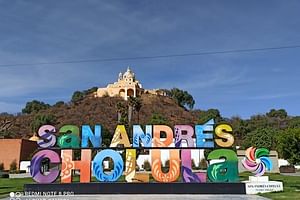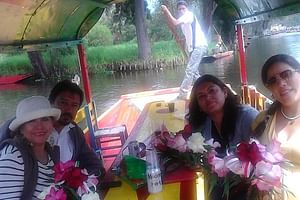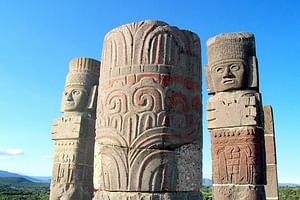The National Museum of Anthropology, houses the largest and most important collection of archeology and anthropology in Mexico in 22 rooms.
The Mexica room, the central highlands, the valleys of Oaxaca, the Mayas among others. Admire some of the most famous pieces such as: The stone of the sun, The mother goddess Cuatlicue, The tomb of Pakal, Estelas from Xochicalco, Atlantes from Tula, Funeral offerings from Monte Alban etc.
The heart of Mexico City hides secrets, stories and legends, stones of archaeological remains in colonial buildings still standing, a Cathedral built on hidden Mexica gods, Palaces, museums, hotels, shops, restaurants and old houses.
Duration
The tour starts at
-
Zocalo (Plaza de la Constitucion)
The Plaza de la Constitución, informally known as El Zócalo, is the main square of Mexico City. It was named in honor of the Cadiz Constitution promulgated in 1812. This is the second largest pla...
The Plaza de la Constitución, informally known as El Zócalo, is the main square of Mexico City. It was named in honor of the Cadiz Constitution promulgated in 1812. This is the second largest plaza in the world and the first among Spanish-speaking countries. 1
The Zócalo is located in the heart of the area known as the Historic Center of Mexico City, in the Cuauhtémoc demarcation. Its location was chosen by the Spanish conquerors to be established just to one side of what was previously the political and religious center of Mexico-Tenochtitlan, capital of the Mexica.
-
Metropolitan Cathedral
The Metropolitan Cathedral of the Assumption of the Blessed Virgin Mary into the heavens of Mexico City is the headquarters of the Archdiocese Primada de México and is located on the north side of...
The Metropolitan Cathedral of the Assumption of the Blessed Virgin Mary into the heavens of Mexico City is the headquarters of the Archdiocese Primada de México and is located on the north side of the Plaza de la Constitución in the Historic Center of Mexico City , in the Cuauhtémoc demarcation. Being part of the aforementioned architectural complex in that area of the city, it is consequently a World Heritage Site since 1987.
The approximate measurements of this temple are 59 meters wide by 128 long and a height of 67 meters to the top of the towers. It is one of the most outstanding works of Hispanic American architecture.
-
Walk down Calle Madero
This street has always been one of the busiest and busiest thoroughfares since colonial times. Its layout is due to the Spanish Alonso García Bravo, so it is also the first streets to be laid out ...
This street has always been one of the busiest and busiest thoroughfares since colonial times. Its layout is due to the Spanish Alonso García Bravo, so it is also the first streets to be laid out over the new Spanish city, over the ruins of the ancient pre-Hispanic city of México-Tenochtitlán.
-
Palace of Mail and Palace of Fine Arts
The term fine arts became popular in the 18th century to refer to the main arts and good use of technique. The first known book that classifies them is Les Beaux-Arts réduits à un même principe ...
The term fine arts became popular in the 18th century to refer to the main arts and good use of technique. The first known book that classifies them is Les Beaux-Arts réduits à un même principe (The fine arts, 1746) by Charles Batteux, who sought to unify the many theories on beauty and taste that existed at that time. Batteux originally included dance, sculpture, music, painting, and poetry in the fine arts; he was later added eloquence.
Over time, the list would undergo changes according to the different authors who would add or remove arts to this list (eloquence was removed). In 1911, Ricciotto Canudo was the first film theorist to qualify it as the seventh art, in his essay "Manifesto of the Seven Arts", which was published in 1914.
-
Panoramic view of Paseo de la Reforma
Paseo de la Reforma is the most important and emblematic avenue in Mexico City. Originally, it was called Paseo de la Emperatriz or Paseo del Emperador, since its line was commissioned by Maximilia...
Paseo de la Reforma is the most important and emblematic avenue in Mexico City. Originally, it was called Paseo de la Emperatriz or Paseo del Emperador, since its line was commissioned by Maximiliano I of Mexico during the Second Mexican Empire. After the triumph of the Benito Juárez government over the latter and the restoration of the republican government, it was renamed Paseo Degollado in honor of Santos Degollado. On the death of Juárez, the government of Sebastián Lerdo de Tejada consolidated its current name in honor of the process known as Reformation.
-
Anthropology Museum
The National Museum of Anthropology (MNA) is one of the most important museum venues in Mexico and America. It is conceived to house and exhibit the archaeological legacy of the Mesoamerican people...
The National Museum of Anthropology (MNA) is one of the most important museum venues in Mexico and America. It is conceived to house and exhibit the archaeological legacy of the Mesoamerican peoples, as well as to account for the current ethnic diversity of the country. The current MNA building was built between 1963 and 1964 in the Chapultepec Forest on the instructions of President Adolfo López Mateos, who inaugurated it on September 17, 1964. Currently, the MNA building has 22 permanent exhibition rooms, two exhibition rooms. temporary exhibitions and three auditoriums. Inside is the National Library of Anthropology and History.
The collection of the National Museum of Anthropology is made up of numerous archaeological and ethnographic pieces from all over Mexico. Some of the most emblematic pieces in the collection include the Stone of the Sun —which is the very heart of the museum—, the colossal heads of the Olmec culture, the monumental Teotihuacan sculptures dedicated to the gods of water, the tomb of Pakal, the funerary offerings of Monte Albán, the stelae of Xochicalco, as well as a Toltec Atlantean brought from Tollan-Xicocotitlan and the Monolith of Tláloc that guards the entrance to the museum.
Round-trip private transfer
Hotel pickup and drop-off
Professional guide
Bottled water
Museum Tickets
Food and drinks
Gratuities











